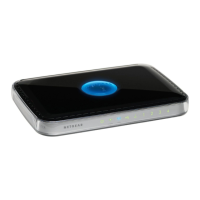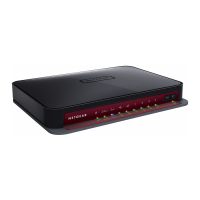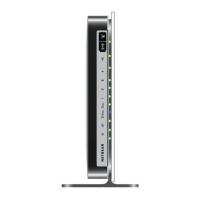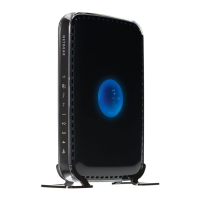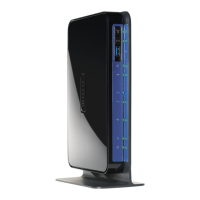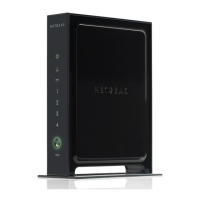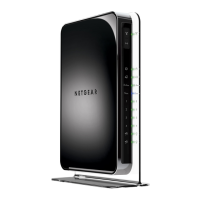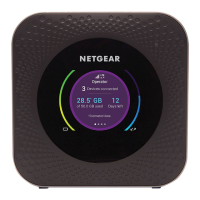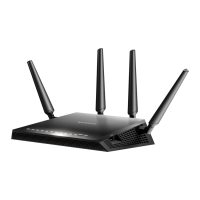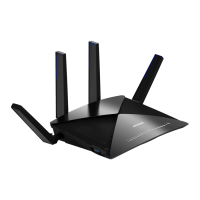Do you have a question about the NETGEAR N600 DGND3700v2 and is the answer not in the manual?
Details on the N600 Wireless Dual Band Gigabit ADSL2+ Modem Router's features and capabilities.
List of items included in the router's box.
Information about the NETGEAR 1-year warranty.
Required hardware and software for the router's operation.
Details on wireless and Ethernet standards supported by the router.
Information on the router's processing power, memory, and ports.
Overview of security features like WPA/WPA2 and firewall protection.
Highlights features like easy installation and Push 'N' Connect.
Description of features like Live Parental Controls.
Instructions for unpacking the wireless modem router and its accessories.
Description of the router's physical components and indicators.
Guidelines for optimal placement of the wireless router for best performance.
Explanation of ADSL microfilters and their use with DSL connections.
Instructions for connecting the router to your network and power.
Steps to confirm correct cabling by checking router LEDs.
Initial steps and information needed before configuring the router.
Instructions for setting up computer network settings for DHCP.
Information required from your Internet Service Provider for setup.
Ensuring wireless devices support WPA/WPA2 security for connection.
Understanding the differences between router and ISP logins.
Step-by-step guide to setting up the router using NETGEAR Genie.
Accessing NETGEAR Genie after the initial setup for configuration changes.
Updating the router's firmware for new features and security.
Overview of the router's dashboard for monitoring network status.
Methods for connecting new devices to the wireless network.
Configuring the router's connection to the Internet and ISP settings.
Viewing and managing devices connected to the network.
Setting up controls to manage internet content access for children.
Managing USB storage devices and printers connected to the router.
Configuring the router's Wi-Fi network name (SSID) and security.
Setting up a separate network for guests with limited access.
Guided setup process for configuring router settings.
Easy setup for WPS-compatible devices using a wizard.
Wizard for configuring VPN connection settings.
Configuring ADSL connection parameters like multiplexing method.
Configuring Wide Area Network settings, DMZ, and MTU size.
Configuring Local Area Network settings, IP addresses, and DHCP.
Prioritizing network traffic based on application, game, or device.
Setting up a DMZ server for specific applications like online games.
Adjusting the Maximum Transmission Unit size for optimal connection performance.
Assigning static IP addresses to devices on the network.
Configuring the router to automatically assign IP addresses to network devices.
Specifications and compatibility for USB storage devices.
Accessing USB storage devices connected to the router.
Examples of how to share files using USB storage.
Configuring basic settings for USB storage devices.
Advanced configuration options for USB storage access.
Procedure for safely disconnecting USB storage devices.
Configuring the router as a DLNA media server.
Setting up the router to share only specific USB devices.
Accessing USB drives remotely over the network.
Configuring the USB Control Center utility for managing shared USB devices.
Setting up and using a USB printer connected to the router.
Using the scan feature of a multifunction printer connected via USB.
Controlling a USB speaker connected to the router.
Blocking specific website keywords or domains.
Configuring rules to block or allow internet traffic.
Setting schedules for when firewall rules are active.
Configuring email alerts for security events.
Updating the router's software to the latest version.
Checking the router's current operational status and information.
Monitoring the status of VPN connections.
Reviewing logs of internet browsing activity.
Backing up, restoring, or erasing router configuration settings.
Changing the router's administrative login password.
Performing diagnostic tests to troubleshoot network issues.
Detailed configuration for wireless network parameters.
Extending wireless network range using WDS technology.
Configuring rules to allow specific inbound traffic.
Making local servers accessible from the Internet.
Dynamically opening ports based on outbound traffic.
Using Dynamic DNS to access the router with a changing IP address.
Configuring static routes for advanced network routing.
Managing the router remotely over the Internet.
Configuring USB port settings for security.
Enabling UPnP for automatic device configuration.
Setting up an IPv6 Internet connection.
Monitoring and limiting internet traffic usage.
Switching the router between Router and Modem modes.
Managing VPN policies for secure tunnels.
General tips for resolving common network issues.
Step-by-step guide for restarting network devices correctly.
Ensuring secure and correct Ethernet cable connections.
Verifying wireless settings match between devices.
Ensuring correct network settings on computers.
Interpreting router LEDs for diagnosing problems.
Troubleshooting steps for a power LED that is off or blinking.
Troubleshooting steps for a power LED that remains red.
Diagnosing issues when router LEDs do not turn off.
Troubleshooting steps when Internet or Ethernet port LEDs are off.
Troubleshooting steps when wireless LEDs are off.
Diagnosing issues when the WPS button blinks red.
Steps to resolve issues preventing login to the router interface.
Troubleshooting steps for when the router is accessible but internet access fails.
Steps to troubleshoot PPPoE connection problems.
Resolving issues with loading web pages despite internet connectivity.
Troubleshooting why router configuration changes are not saved.
Resolving issues with the router's date and time settings.
Steps to isolate and fix wireless connection problems.
Diagnosing and improving weak wireless signal strength.
Procedures for resetting the router to factory defaults and passwords.
Using the ping utility to diagnose network connectivity.
Verifying the LAN connection path to the router.
Testing network connectivity to remote devices.
Default configuration settings for the wireless modem router.
Detailed technical specifications of the N600 Wireless Dual Band Gigabit ADSL2+ Modem Router.
User requirements for operating radio devices according to national laws.
Compliance with EU directives for radio and telecommunications equipment.
Information on FCC regulations for device operation in the US.
FCC limits for radiation exposure and installation guidelines.
Statement of compliance with FCC rules for the N600 Wireless Dual Band Gigabit ADSL2+ Modem Router.
Details on the N600 Wireless Dual Band Gigabit ADSL2+ Modem Router's features and capabilities.
List of items included in the router's box.
Information about the NETGEAR 1-year warranty.
Required hardware and software for the router's operation.
Details on wireless and Ethernet standards supported by the router.
Information on the router's processing power, memory, and ports.
Overview of security features like WPA/WPA2 and firewall protection.
Highlights features like easy installation and Push 'N' Connect.
Description of features like Live Parental Controls.
Instructions for unpacking the wireless modem router and its accessories.
Description of the router's physical components and indicators.
Guidelines for optimal placement of the wireless router for best performance.
Explanation of ADSL microfilters and their use with DSL connections.
Instructions for connecting the router to your network and power.
Steps to confirm correct cabling by checking router LEDs.
Initial steps and information needed before configuring the router.
Instructions for setting up computer network settings for DHCP.
Information required from your Internet Service Provider for setup.
Ensuring wireless devices support WPA/WPA2 security for connection.
Understanding the differences between router and ISP logins.
Step-by-step guide to setting up the router using NETGEAR Genie.
Accessing NETGEAR Genie after the initial setup for configuration changes.
Updating the router's firmware for new features and security.
Overview of the router's dashboard for monitoring network status.
Methods for connecting new devices to the wireless network.
Configuring the router's connection to the Internet and ISP settings.
Viewing and managing devices connected to the network.
Setting up controls to manage internet content access for children.
Managing USB storage devices and printers connected to the router.
Configuring the router's Wi-Fi network name (SSID) and security.
Setting up a separate network for guests with limited access.
Guided setup process for configuring router settings.
Easy setup for WPS-compatible devices using a wizard.
Wizard for configuring VPN connection settings.
Configuring ADSL connection parameters like multiplexing method.
Configuring Wide Area Network settings, DMZ, and MTU size.
Configuring Local Area Network settings, IP addresses, and DHCP.
Prioritizing network traffic based on application, game, or device.
Setting up a DMZ server for specific applications like online games.
Adjusting the Maximum Transmission Unit size for optimal connection performance.
Assigning static IP addresses to devices on the network.
Configuring the router to automatically assign IP addresses to network devices.
Specifications and compatibility for USB storage devices.
Accessing USB storage devices connected to the router.
Examples of how to share files using USB storage.
Configuring basic settings for USB storage devices.
Advanced configuration options for USB storage access.
Procedure for safely disconnecting USB storage devices.
Configuring the router as a DLNA media server.
Setting up the router to share only specific USB devices.
Accessing USB drives remotely over the network.
Configuring the USB Control Center utility for managing shared USB devices.
Setting up and using a USB printer connected to the router.
Using the scan feature of a multifunction printer connected via USB.
Controlling a USB speaker connected to the router.
Blocking specific website keywords or domains.
Configuring rules to block or allow internet traffic.
Setting schedules for when firewall rules are active.
Configuring email alerts for security events.
Updating the router's software to the latest version.
Checking the router's current operational status and information.
Monitoring the status of VPN connections.
Reviewing logs of internet browsing activity.
Backing up, restoring, or erasing router configuration settings.
Changing the router's administrative login password.
Performing diagnostic tests to troubleshoot network issues.
Detailed configuration for wireless network parameters.
Extending wireless network range using WDS technology.
Configuring rules to allow specific inbound traffic.
Making local servers accessible from the Internet.
Dynamically opening ports based on outbound traffic.
Using Dynamic DNS to access the router with a changing IP address.
Configuring static routes for advanced network routing.
Managing the router remotely over the Internet.
Configuring USB port settings for security.
Enabling UPnP for automatic device configuration.
Setting up an IPv6 Internet connection.
Monitoring and limiting internet traffic usage.
Switching the router between Router and Modem modes.
Managing VPN policies for secure tunnels.
General tips for resolving common network issues.
Step-by-step guide for restarting network devices correctly.
Ensuring secure and correct Ethernet cable connections.
Verifying wireless settings match between devices.
Ensuring correct network settings on computers.
Interpreting router LEDs for diagnosing problems.
Troubleshooting steps for a power LED that is off or blinking.
Troubleshooting steps for a power LED that remains red.
Diagnosing issues when router LEDs do not turn off.
Troubleshooting steps when Internet or Ethernet port LEDs are off.
Troubleshooting steps when wireless LEDs are off.
Diagnosing issues when the WPS button blinks red.
Steps to resolve issues preventing login to the router interface.
Troubleshooting steps for when the router is accessible but internet access fails.
Steps to troubleshoot PPPoE connection problems.
Resolving issues with loading web pages despite internet connectivity.
Troubleshooting why router configuration changes are not saved.
Resolving issues with the router's date and time settings.
Steps to isolate and fix wireless connection problems.
Diagnosing and improving weak wireless signal strength.
Procedures for resetting the router to factory defaults and passwords.
Using the ping utility to diagnose network connectivity.
Verifying the LAN connection path to the router.
Testing network connectivity to remote devices.
Default configuration settings for the wireless modem router.
Detailed technical specifications of the N600 Wireless Dual Band Gigabit ADSL2+ Modem Router.
User requirements for operating radio devices according to national laws.
Compliance with EU directives for radio and telecommunications equipment.
Information on FCC regulations for device operation in the US.
FCC limits for radiation exposure and installation guidelines.
Statement of compliance with FCC rules for the N600 Wireless Dual Band Gigabit ADSL2+ Modem Router.
| Model | DGND3700v2 |
|---|---|
| Category | Wireless Router |
| Wireless Standards | IEEE 802.11 a/b/g/n |
| USB Ports | 1 x USB 2.0 |
| Modem Type | ADSL2+ |
| Frequency Band | 2.4 GHz and 5 GHz |
| Security Features | WPA/WPA2, WEP |
| Firewall | NAT, SPI |
| Wireless Speed | Up to 300 Mbps on 2.4 GHz, Up to 300 Mbps on 5 GHz |
| Ethernet Ports | 5 (1 WAN, 4 LAN) Gigabit Ethernet ports |

